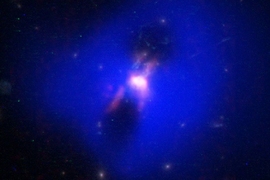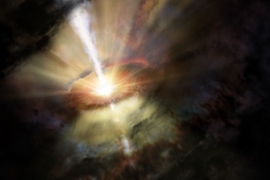This week, the Hydrogen Epoch of Reionization Array (HERA) telescope project team was awarded a grant from the Gordon and Betty Moore Foundation to MIT to expand the HERA telescope in South Africa to begin looking for the effects of light from the first generation of stars that formed in the universe.
HERA, an international project led by researchers at the University of California at Berkeley, with initial funding from the National Science Foundation (NSF), is looking for signals from the “epoch of reionization” (EoR) when 90 percent of the hydrogen atoms created in the early universe were destroyed by the first luminous stars and black holes. The enhancement of the array, supported by the additional funding and carried out in partnership with MIT, the University of Virginia, and the National Radio Astronomy Observatory, will increase HERA's capability in several different ways.
“Expanding HERA will help us map bubbles of ionization around early galaxies in our universe and will extend our ability to find the earliest signs of star formation in our universe,” said Aaron Parsons, lead investigator on the HERA project and associate professor of astronomy at UC Berkeley, who noted the importance of collecting area and bandwidth for accessing a cosmological signal roughly 100,000 times fainter than emission from the Milky Way and nearby galaxies.
With the grant from the Moore Foundation, the team can increase the sensitivity of the array and potentially detect signals coming from a time before the EoR in the history of the universe, the cosmic dawn, roughly 400 million years after the Big Bang. Using this next-generation in instrumentation for 21-cm cosmology — the wavelength of neutral hydrogen gas radio waves — HERA will probe the 3-D structure of the universe during the very first appearance of stars, galaxies, and black holes. This first generation of hot massive stars and black-hole binaries filled the intergalactic medium with X-rays.
“These X-rays would have heated up the hydrogen surrounding galaxies and should produce detectable fluctuations in the 21cm line,” said Jacqueline N Hewitt, lead investigator on the Moore Foundation grant, and director of the MIT Kavli Institute for Astrophysics and Space Research. “Measurements of the ‘Epoch of X-rays’ power spectrum could, in principle, distinguish between different scenarios for the very first generation of stars.”
Located at the South African Karoo Astronomy Reserve, HERA’s radio antennae use a low-frequency range of 50-250 MHz to detect fluctuations in emissions from neutral hydrogen gas found throughout the universe during the formation of stars, galaxies, and black holes. The array’s 14-meter dishes are sensitive to hydrogen at great distances, shifted downward in radio frequency by the expansion of the universe. The performance of the array will be enhanced by adding 110 antennae elements to the currently planned 240-antennae array and by extending its performance to lower radio frequencies.
Work to begin adding the additional antennae to the array will begin in the summer of 2018, and collection of data with the full array is slated to begin about a year later. NSF originally began supporting parallel efforts by U.S. teams to develop instrumentation to observe the EoR in the early 2000s, leading to a convergence of those teams to build HERA.
This research is funded by the Gordon and Betty Moore Foundation. HERA received major grants from NSF's Mid-Scale Innovations Program in 2014 and 2016. The HERA collaboration consists of Arizona State University, Brown University, the University of Cambridge, MIT, the National Radio Astronomy Observatory, Scuola Normale Superiore (Pisa), the Square Kilometre Array Organization South Africa, the University of California at Berkeley, the University of California at Los Angeles, the University of Pennsylvania, and the University of Washington.










